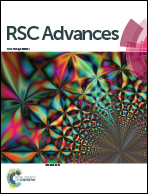Novel naproxen-peptide-conjugated amphiphilic dendrimer self-assembly micelles for targeting drug delivery to osteosarcoma cells†
Abstract
The aim of the current study was to synthesize and prepare novel self-assembly micelles loaded with curcumin (Cur) based on naproxen (Nap)-conjugated amphiphilic dendrimers. The apoptosis-inducing capacity of Nap-conjugated dendrimers and curcumin, the efficiency of uptake and the potential molecular mechanism on human osteosarcoma cells were investigated. The Nap-conjugated amphiphilic dendrimers were successfully synthesized, and the corresponding Cur-loaded micelles were conventionally prepared via self-assembly. These micelles showed good drug-encapsulating capacity, physiochemical properties, and drug-release profiles. The cellular proliferation and uptake assay suggested that the Cur-M-Nap induced more apoptosis of MG-63 human osteosarcoma cells. The western blot results suggested that these Nap-modified micelles could enhance the Cur-inducing apoptosis, mainly via intrinsic pathways and inhibition of the inflammation pathway. In summary, the Cur-loaded amphiphilic dendrimer-based micelles were successfully developed and they enhanced drug delivery to MG-63 cells. Mechanistic experiments suggested that Cur loaded into amphiphilic dendrimer-based micelles had a higher proliferation-inhibiting ability than free Cur, and could induce more apoptosis.


 Please wait while we load your content...
Please wait while we load your content...